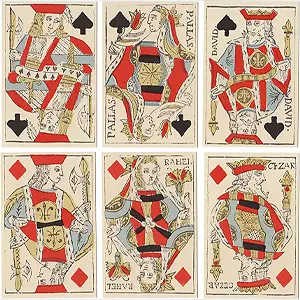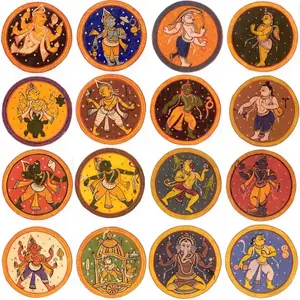Differences in Cards Across the World
George | January 18, 2018
Think of a deck of playing cards. It’s almost certain you pictured a deck of 52 cards, with spades, clubs, hearts, and diamonds. This is by far the most common deck, the one you’ll find in your kitchen and online.
However, depending on where you are, a deck of cards could consist of anywhere from 36 to 78 cards, and most feature completely different imagery. Some aren’t even rectangular! If you’re curious, read on to see what the cards look like in different parts of the world.
French-suited pack

This is the deck you’re most familiar with. Born in France, the familiar Hearts, Spades, Diamonds, and Clubs are known worldwide, even in countries that use their own local designs. Interestingly, this deck established the queen as a firm staple of playing cards, as most decks at the time had King, Knight, and Knave. The face cards also correlate with figures from myth and history. For instance, did you know the Jack of Clubs represents Lancelot? But, since this is the deck you know, let’s talk about some of the more interesting ones.
Italian-suited pack
These cards may still sound familiar as Italian decks have influenced another major selection of cards. In traditional Italian decks, you have four suits: Swords, Coins, Wands, and Cups. These are the suits of the minor arcana in Tarot decks! Tarot decks were used for playing different games with a second set of cards, forming a different means of landing trumps, which boosted the total number of cards in a deck to 78. These same suits are used in Spanish decks, but Spanish decks don’t contain a ten, meaning they have 48 cards total. This may sound low, but just wait until we get to the next country.
German-suited pack
The German suits share one in common with the French deck: the Heart. The other suits are more esoteric, consisting of Acorns, Leaves, and Bells. It’s possible that the Leaf suit influenced the Spade symbol of the French deck, as it looks rather leaf-like compared to the sword it’s named after. This deck contains just 32 cards, making it difficult to play non-Germanic games with them. Some Italian manufacturers started producing 40-card variants for the Southern Tyrol region, allowing players to have cards that looked the part while still being able to play Italian games.
Ganjifa and Mahjong

This may stretch the definition of a card, as neither of these games use printed paper. Ganjifa, from India, uses flat discs with various symbols and plays much like a trick-taking game, with suits similar to the Italian deck from which it originated.
Mahjong is perhaps better known and is incredibly popular in China and other Asian countries. It has a similar setup with numbered tiles in suits. The three suits, numbered 1-9, are Dots, Bamboo, and Characters, along with a number of Trumps in a series of four. Because of its similar play style, even though the cards are clearly tiles, Mahjong is probably the most unique example of a deck of cards.